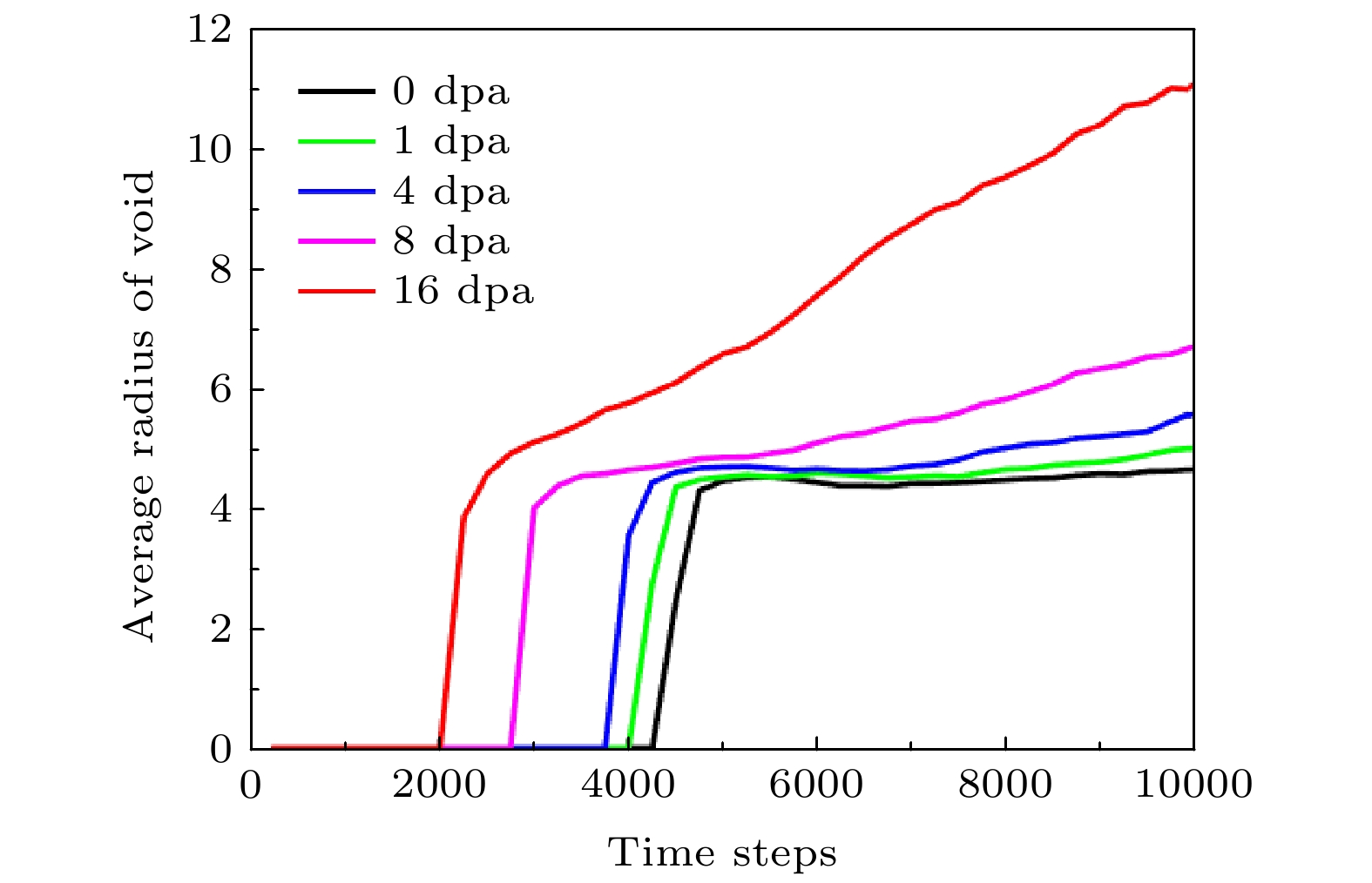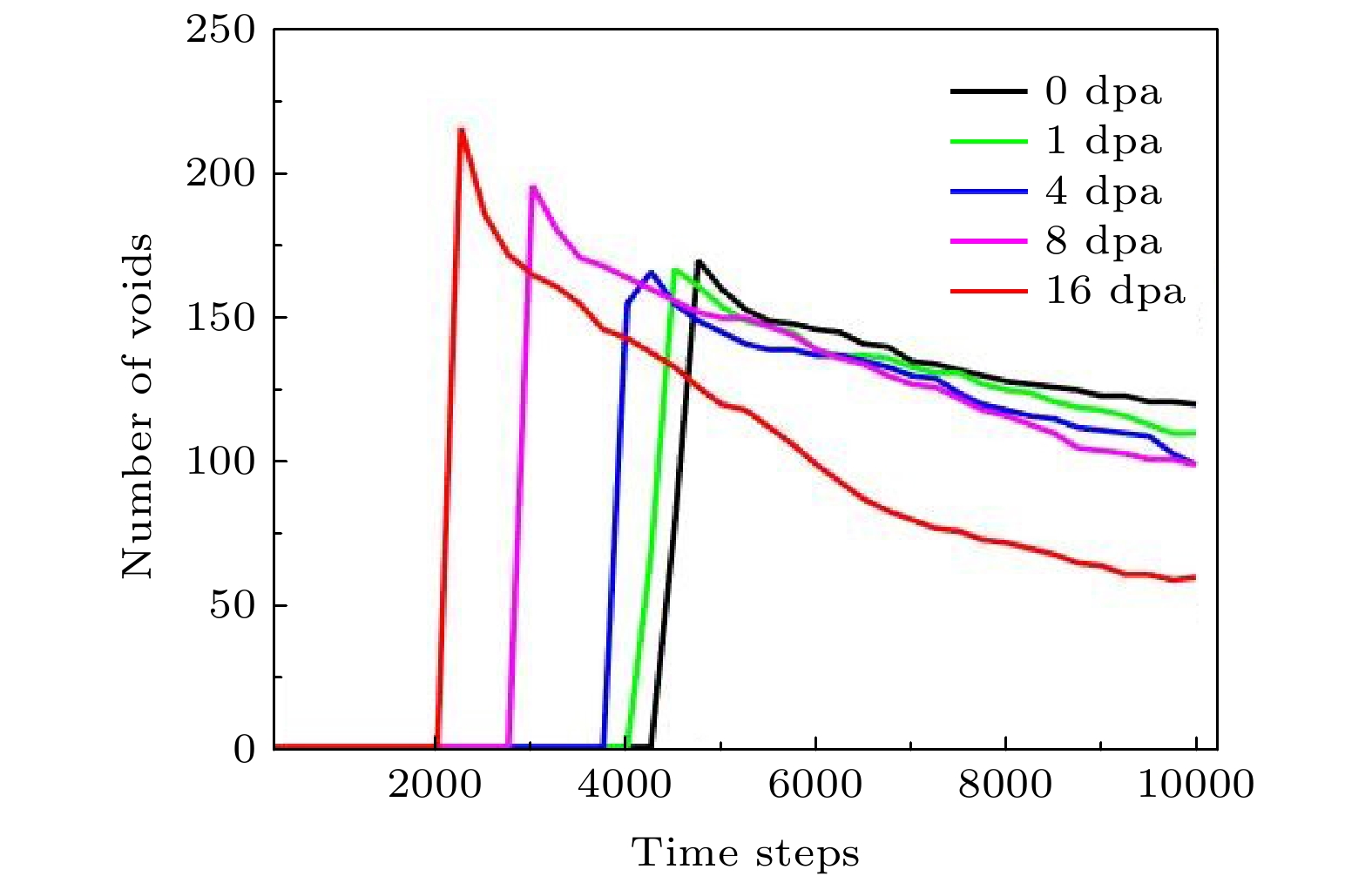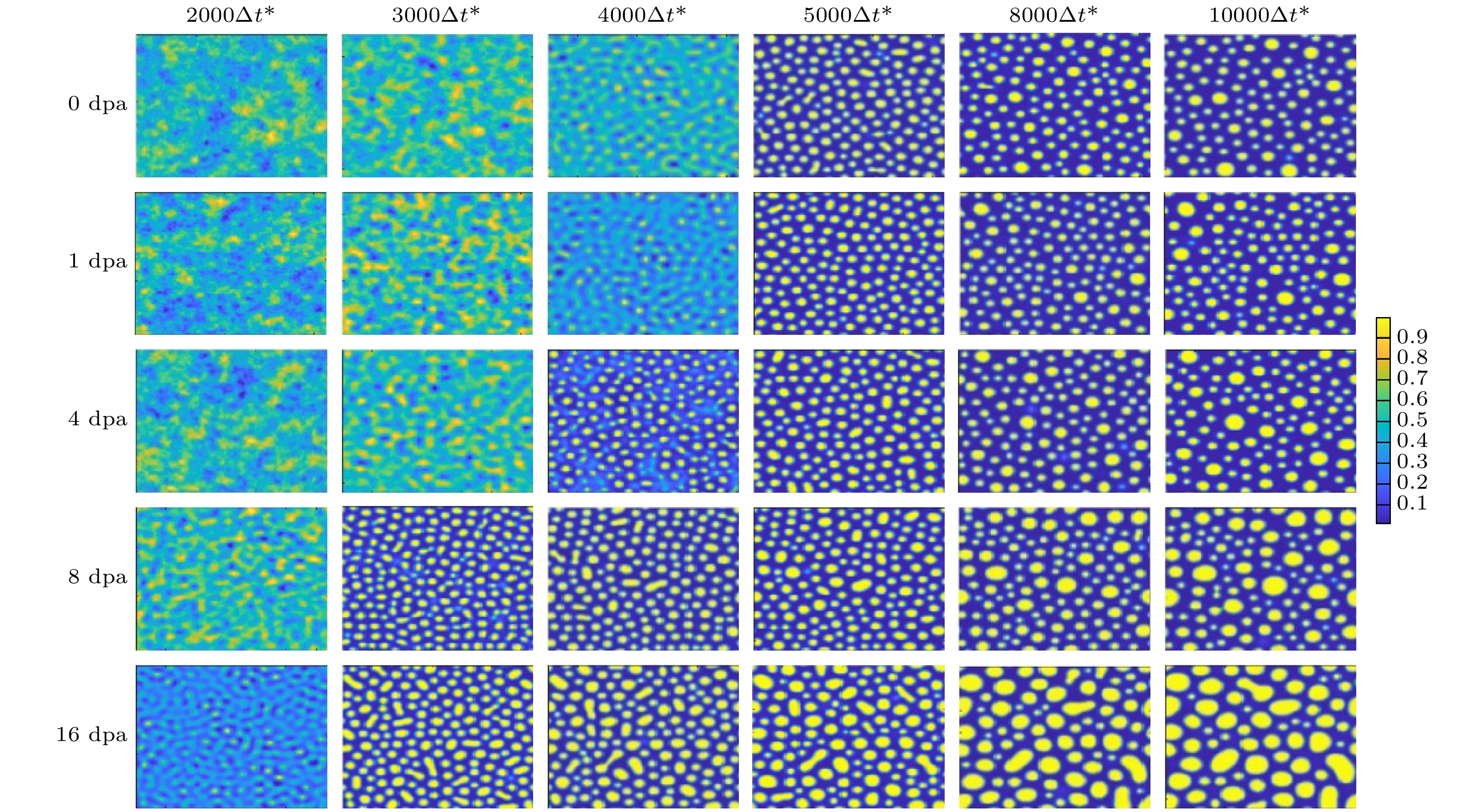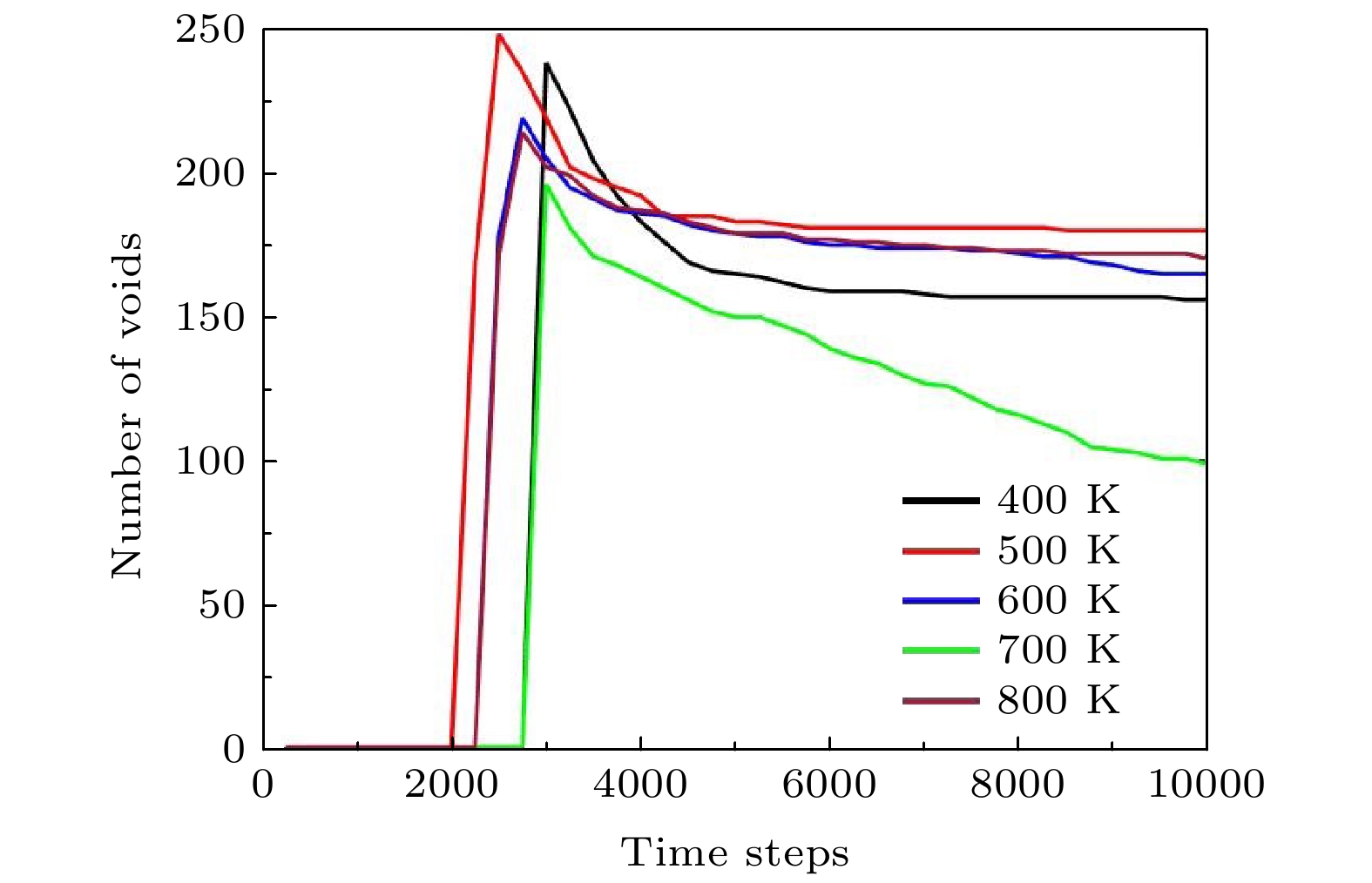-
As cladding materials, Fe-Cr alloys are used in the extreme environments of high temperature, high pressure, and energetic particle radiation, thus generating irradiation defects such as vacancies and interstitials. The clustering of irradiation defects leads the voids or dislocation loops to form, resulting in irradiation swelling and lattice distortion, and further radiation hardening or softening, finally, material failure. It is beneficial to tailor desired microstructures and obtain stable service performances by understanding defects cluster and voids formation process. In this paper, the phase-field method is employed to study the evolution of voids of Fe-Cr alloy. In the model the temperature effects on point defects and generation/recombination of vacancies and interstitials are taken into consideration. The 400–800 K temperature range and 0–16 dpa radiation dose range are selected, in which the voids’ formation process including generation and recombination, as well as vacancy clustering caused by vacancy diffusion, is studied for Fe-Cr alloy. The nucleation rate of the void cluster shows a trend of first increasing and then decreasing with temperature increasing from 400 to 800 K. This phenomenon is related to complex interactions among defects concentration, atomic diffusion, recombination, nucleation, and growth conditions. At a given temperature, the average radius and the volume fraction of the voids grow bigger as the radiation dose increases. With the increase of irradiation dose, the cascade collision reaction is strengthened, and the number of Frenkel defect pairs is also increases. A large number of vacancies and interstitial atoms are generated, and the rapid diffusion and accumulation of vacancies in the Fe-Cr alloy at high temperature form a larger number and larger size of voids. The incubation period of vacancy clusters and voids are quite different due to the influence of irradiation temperature and dose. The higher the irradiation dose, the shorter the incubation period is. The relationship between the incubation period and temperature is more complicated. When the temperature is relatively low, the incubation period is shortened as the temperature increases, and as the temperature continues to increase to a higher temperature, the incubation period is extended. This relates to the increase in the concentration of vacancies, the recombination of vacancies and interstitials, and the increase of the critical nucleus radius for the growth of voids when the temperature increases.
-
Keywords:
- phase-field method /
- void evolution /
- irradiation dose /
- cascade collision
[1] Klueh R L, Nelson A T 2007 J. Nucl. Mater. 371 37
 Google Scholar
Google Scholar
[2] Buongiorno J, Swindeman R, Corwin W, Rowchitte A, McDonald P, Was G, Mansur L, Wikon D, Nanstad R, Wright I 2003 Supercritical Water Reactor (SCWR) : Survey of Materials Experience and R&D Needs to Assess Viability, Idaho National EngineeringLaboratory Report INEEL/EXT-03-00693 (Rev. 1) Idaho September 2003
[3] Sass S L, Eyre B L 1973 Philos. Mag. 27 1447
 Google Scholar
Google Scholar
[4] Une K, Nogita K, Kashibe S, Imamura M 1992 J. Nucl. Mater. 188 65
 Google Scholar
Google Scholar
[5] Nogita K, Une K 1993 J. Nucl. Mater. 91 301
[6] Zacharie I, Lansiart S, Combette P, Trotabas M, Coster M, Groos M 1998 J. Nucl. Mater. 255 92
 Google Scholar
Google Scholar
[7] Katsuyama K, Nagamine T, Matsumoto S, Ito M 2002 J. Nucl. Sci. Technol. 39 804
 Google Scholar
Google Scholar
[8] 张娜, 刘波, 林黎蔚 2020 69 016101
 Google Scholar
Google Scholar
Zhang N, Liu B, Lin L W 2020 Acta Phys. Sin. 69 016101
 Google Scholar
Google Scholar
[9] 高云亮, 朱芫江, 李进平 2017 66 057104
 Google Scholar
Google Scholar
Gao Y L, Zhu Y J, Li J P 2017 Acta Phys. Sin. 66 057104
 Google Scholar
Google Scholar
[10] Lindhard J, Nielsen V, Scharff M, Thomsen P V 1963 Mat. Fys. Medd. Dan. Vid. Selsk. 33 706
[11] 郁金南 2007 核材料科学与工程——材料辐照效应 (北京: 化学工业出版社) 第198—203页
Yu J N 2007 Nuclear Materials Science and Engineering Radiation Effects of Materials (Beijing: Chemical Industry Press) pp198–203 (in Chinese)
[12] Becker C H 1972 US Patent 3 657 707 [1972-4-18]
[13] 黄鹤飞, 李健健, 刘仁多, 陈怀灿, 闫隆 2014 金属学报 50 1189
 Google Scholar
Google Scholar
Huang H F, Li J J, Liu R D, Chen H C, Yan L 2014 J. Acta Metall. Sin. 50 1189
 Google Scholar
Google Scholar
[14] 丁兆楠, 杨义涛, 宋银, 张丽卿, 缑洁, 张崇宏, 罗广南 2017 66 112501
 Google Scholar
Google Scholar
Ding Z N, Yang Y T, Song Y, Zhang L Q, Gou J, Zhang C H, Luo G N 2017 Acta Phys. Sin. 66 112501
 Google Scholar
Google Scholar
[15] Lambrecht M, Malerba L 2011 Acta Mater. 59 6547
 Google Scholar
Google Scholar
[16] Reese E R, Almirall N, Yamamoto T 2018 Scr. Mater. 146 213
 Google Scholar
Google Scholar
[17] Liu Y L, Zhang Y, Zhou H B 2009 Phys. Rev. B 79 172103
 Google Scholar
Google Scholar
[18] Zhou H B, Liu Y L, Jin S 2010 Nucl. Fusi. 50 115010
 Google Scholar
Google Scholar
[19] Alkhamees A, Liu Y L, Zhou H B 2009 J. Nucl. Mater. 393 508
 Google Scholar
Google Scholar
[20] 梁晋洁, 高宁, 李玉红 2020 69 116102
 Google Scholar
Google Scholar
Liang J J, Gao N, Li Y H 2020 Acta Phys. Sin. 69 116102
 Google Scholar
Google Scholar
[21] 朱琪, 王升涛, 赵福祺, 潘昊 2020 69 036201
 Google Scholar
Google Scholar
Zhu Q, Wang S T, Zhao F Q, Pan H 2020 Acta Phys. Sin. 69 036201
 Google Scholar
Google Scholar
[22] 梁晋洁, 高宁, 李玉红 2020 69 036101
 Google Scholar
Google Scholar
Liang J J, Gao N, Li Y H 2020 Acta Phys. Sin. 69 036101
 Google Scholar
Google Scholar
[23] 梁林云, 吕广宏 2013 62 182801
 Google Scholar
Google Scholar
Liang L Y, Lü G H 2013 Acta Phys. Sin. 62 182801
 Google Scholar
Google Scholar
[24] 李然然, 张一帆, 耿殿程, 张高伟, 渡边英雄, 韩文妥, 万发荣 2019 68 216101
 Google Scholar
Google Scholar
Li R R, Zhang Y F, Geng D C, Zhang G W, Watanabe Hideo, Han W T, Wan F R 2019 Acta Phys. Sin. 68 216101
 Google Scholar
Google Scholar
[25] Hu S Y, Henager C H, Heinisch H L 2009 J. Nucl. Mater. 392 292
 Google Scholar
Google Scholar
[26] Rokkam S, El-Azab A, Millett P 2009 Model Simul. Mater.Sci. Eng. 17 064002
 Google Scholar
Google Scholar
[27] Millett P C, Rokkam S, El-Azab A 2009 Model Simul. Mater. Sci. Eng. 17 064003
 Google Scholar
Google Scholar
[28] Zhao B J, Zhao Y H, Sun Y Y, Yang W K, Hou H 2019 Acta Metall. Sin. 55 593
[29] Yan Z W, Shi S J, Li Y S, Chen J, Maqbool S 2020 Phys. Chem. Chem. Phys. 22 3611
 Google Scholar
Google Scholar
[30] Provatas N, Elder K 2010 Phase-field Methods in Materials Science and Engineering (Germany: Weinheim Wiley-VCH) pp2−5
[31] Hu S Y, Henager C H 2010 Acta Mater. 58 3230
 Google Scholar
Google Scholar
[32] Li Y, Hu S, Sun X 2010 J. Nucl. Mater. 407 119
 Google Scholar
Google Scholar
[33] Simeone D, Ribis J, Luneville L 2018 J. Mater. Res. 33 440
 Google Scholar
Google Scholar
[34] Ortiz C J, Caturla M J 2007 Phys. Rev. B 75 184101
 Google Scholar
Google Scholar
[35] Bacon D J, Gao F, Osetsky Y N 2000 J. Nucl. Mater. 276 1
 Google Scholar
Google Scholar
[36] Souidi A, Becquart C S, Domain C 2006 J. Nucl. Mater. 355 89
 Google Scholar
Google Scholar
[37] Boisse J, Domain C, Becquart C S 2014 J. Nucl. Mater. 455 10
 Google Scholar
Google Scholar
[38] 徐恒均 2009 材料科学基础(第一版)(北京: 北京工业大学出版社) 第205−214页
Xu H J 2009 Foundations of Materials Science (Vol.1) (Beijjing: Beijing University of Technology Press) pp205−214 (in Chinese)
[39] Wong K L, Lee H J, Shim J H, Sadigh B, Wirth B D 2009 J. Nucl. Mater 386 227
[40] Norris, D I R 1972 Radiation Effects 14 1
 Google Scholar
Google Scholar
[41] Getto E, Jiao Z, Monterrosa A M 2015 J. Nucl.Mater. 462 458
 Google Scholar
Google Scholar
[42] Toloczko M B, Garner F A, Voyevodin V N 2014 J. Nucl.Mater. 453 323
 Google Scholar
Google Scholar
[43] Brailsford A D, Bullough R, Hayns M R 1978 J. Nucl. Mater. 60 246
-
-
[1] Klueh R L, Nelson A T 2007 J. Nucl. Mater. 371 37
 Google Scholar
Google Scholar
[2] Buongiorno J, Swindeman R, Corwin W, Rowchitte A, McDonald P, Was G, Mansur L, Wikon D, Nanstad R, Wright I 2003 Supercritical Water Reactor (SCWR) : Survey of Materials Experience and R&D Needs to Assess Viability, Idaho National EngineeringLaboratory Report INEEL/EXT-03-00693 (Rev. 1) Idaho September 2003
[3] Sass S L, Eyre B L 1973 Philos. Mag. 27 1447
 Google Scholar
Google Scholar
[4] Une K, Nogita K, Kashibe S, Imamura M 1992 J. Nucl. Mater. 188 65
 Google Scholar
Google Scholar
[5] Nogita K, Une K 1993 J. Nucl. Mater. 91 301
[6] Zacharie I, Lansiart S, Combette P, Trotabas M, Coster M, Groos M 1998 J. Nucl. Mater. 255 92
 Google Scholar
Google Scholar
[7] Katsuyama K, Nagamine T, Matsumoto S, Ito M 2002 J. Nucl. Sci. Technol. 39 804
 Google Scholar
Google Scholar
[8] 张娜, 刘波, 林黎蔚 2020 69 016101
 Google Scholar
Google Scholar
Zhang N, Liu B, Lin L W 2020 Acta Phys. Sin. 69 016101
 Google Scholar
Google Scholar
[9] 高云亮, 朱芫江, 李进平 2017 66 057104
 Google Scholar
Google Scholar
Gao Y L, Zhu Y J, Li J P 2017 Acta Phys. Sin. 66 057104
 Google Scholar
Google Scholar
[10] Lindhard J, Nielsen V, Scharff M, Thomsen P V 1963 Mat. Fys. Medd. Dan. Vid. Selsk. 33 706
[11] 郁金南 2007 核材料科学与工程——材料辐照效应 (北京: 化学工业出版社) 第198—203页
Yu J N 2007 Nuclear Materials Science and Engineering Radiation Effects of Materials (Beijing: Chemical Industry Press) pp198–203 (in Chinese)
[12] Becker C H 1972 US Patent 3 657 707 [1972-4-18]
[13] 黄鹤飞, 李健健, 刘仁多, 陈怀灿, 闫隆 2014 金属学报 50 1189
 Google Scholar
Google Scholar
Huang H F, Li J J, Liu R D, Chen H C, Yan L 2014 J. Acta Metall. Sin. 50 1189
 Google Scholar
Google Scholar
[14] 丁兆楠, 杨义涛, 宋银, 张丽卿, 缑洁, 张崇宏, 罗广南 2017 66 112501
 Google Scholar
Google Scholar
Ding Z N, Yang Y T, Song Y, Zhang L Q, Gou J, Zhang C H, Luo G N 2017 Acta Phys. Sin. 66 112501
 Google Scholar
Google Scholar
[15] Lambrecht M, Malerba L 2011 Acta Mater. 59 6547
 Google Scholar
Google Scholar
[16] Reese E R, Almirall N, Yamamoto T 2018 Scr. Mater. 146 213
 Google Scholar
Google Scholar
[17] Liu Y L, Zhang Y, Zhou H B 2009 Phys. Rev. B 79 172103
 Google Scholar
Google Scholar
[18] Zhou H B, Liu Y L, Jin S 2010 Nucl. Fusi. 50 115010
 Google Scholar
Google Scholar
[19] Alkhamees A, Liu Y L, Zhou H B 2009 J. Nucl. Mater. 393 508
 Google Scholar
Google Scholar
[20] 梁晋洁, 高宁, 李玉红 2020 69 116102
 Google Scholar
Google Scholar
Liang J J, Gao N, Li Y H 2020 Acta Phys. Sin. 69 116102
 Google Scholar
Google Scholar
[21] 朱琪, 王升涛, 赵福祺, 潘昊 2020 69 036201
 Google Scholar
Google Scholar
Zhu Q, Wang S T, Zhao F Q, Pan H 2020 Acta Phys. Sin. 69 036201
 Google Scholar
Google Scholar
[22] 梁晋洁, 高宁, 李玉红 2020 69 036101
 Google Scholar
Google Scholar
Liang J J, Gao N, Li Y H 2020 Acta Phys. Sin. 69 036101
 Google Scholar
Google Scholar
[23] 梁林云, 吕广宏 2013 62 182801
 Google Scholar
Google Scholar
Liang L Y, Lü G H 2013 Acta Phys. Sin. 62 182801
 Google Scholar
Google Scholar
[24] 李然然, 张一帆, 耿殿程, 张高伟, 渡边英雄, 韩文妥, 万发荣 2019 68 216101
 Google Scholar
Google Scholar
Li R R, Zhang Y F, Geng D C, Zhang G W, Watanabe Hideo, Han W T, Wan F R 2019 Acta Phys. Sin. 68 216101
 Google Scholar
Google Scholar
[25] Hu S Y, Henager C H, Heinisch H L 2009 J. Nucl. Mater. 392 292
 Google Scholar
Google Scholar
[26] Rokkam S, El-Azab A, Millett P 2009 Model Simul. Mater.Sci. Eng. 17 064002
 Google Scholar
Google Scholar
[27] Millett P C, Rokkam S, El-Azab A 2009 Model Simul. Mater. Sci. Eng. 17 064003
 Google Scholar
Google Scholar
[28] Zhao B J, Zhao Y H, Sun Y Y, Yang W K, Hou H 2019 Acta Metall. Sin. 55 593
[29] Yan Z W, Shi S J, Li Y S, Chen J, Maqbool S 2020 Phys. Chem. Chem. Phys. 22 3611
 Google Scholar
Google Scholar
[30] Provatas N, Elder K 2010 Phase-field Methods in Materials Science and Engineering (Germany: Weinheim Wiley-VCH) pp2−5
[31] Hu S Y, Henager C H 2010 Acta Mater. 58 3230
 Google Scholar
Google Scholar
[32] Li Y, Hu S, Sun X 2010 J. Nucl. Mater. 407 119
 Google Scholar
Google Scholar
[33] Simeone D, Ribis J, Luneville L 2018 J. Mater. Res. 33 440
 Google Scholar
Google Scholar
[34] Ortiz C J, Caturla M J 2007 Phys. Rev. B 75 184101
 Google Scholar
Google Scholar
[35] Bacon D J, Gao F, Osetsky Y N 2000 J. Nucl. Mater. 276 1
 Google Scholar
Google Scholar
[36] Souidi A, Becquart C S, Domain C 2006 J. Nucl. Mater. 355 89
 Google Scholar
Google Scholar
[37] Boisse J, Domain C, Becquart C S 2014 J. Nucl. Mater. 455 10
 Google Scholar
Google Scholar
[38] 徐恒均 2009 材料科学基础(第一版)(北京: 北京工业大学出版社) 第205−214页
Xu H J 2009 Foundations of Materials Science (Vol.1) (Beijjing: Beijing University of Technology Press) pp205−214 (in Chinese)
[39] Wong K L, Lee H J, Shim J H, Sadigh B, Wirth B D 2009 J. Nucl. Mater 386 227
[40] Norris, D I R 1972 Radiation Effects 14 1
 Google Scholar
Google Scholar
[41] Getto E, Jiao Z, Monterrosa A M 2015 J. Nucl.Mater. 462 458
 Google Scholar
Google Scholar
[42] Toloczko M B, Garner F A, Voyevodin V N 2014 J. Nucl.Mater. 453 323
 Google Scholar
Google Scholar
[43] Brailsford A D, Bullough R, Hayns M R 1978 J. Nucl. Mater. 60 246
Catalog
Metrics
- Abstract views: 9213
- PDF Downloads: 166
- Cited By: 0














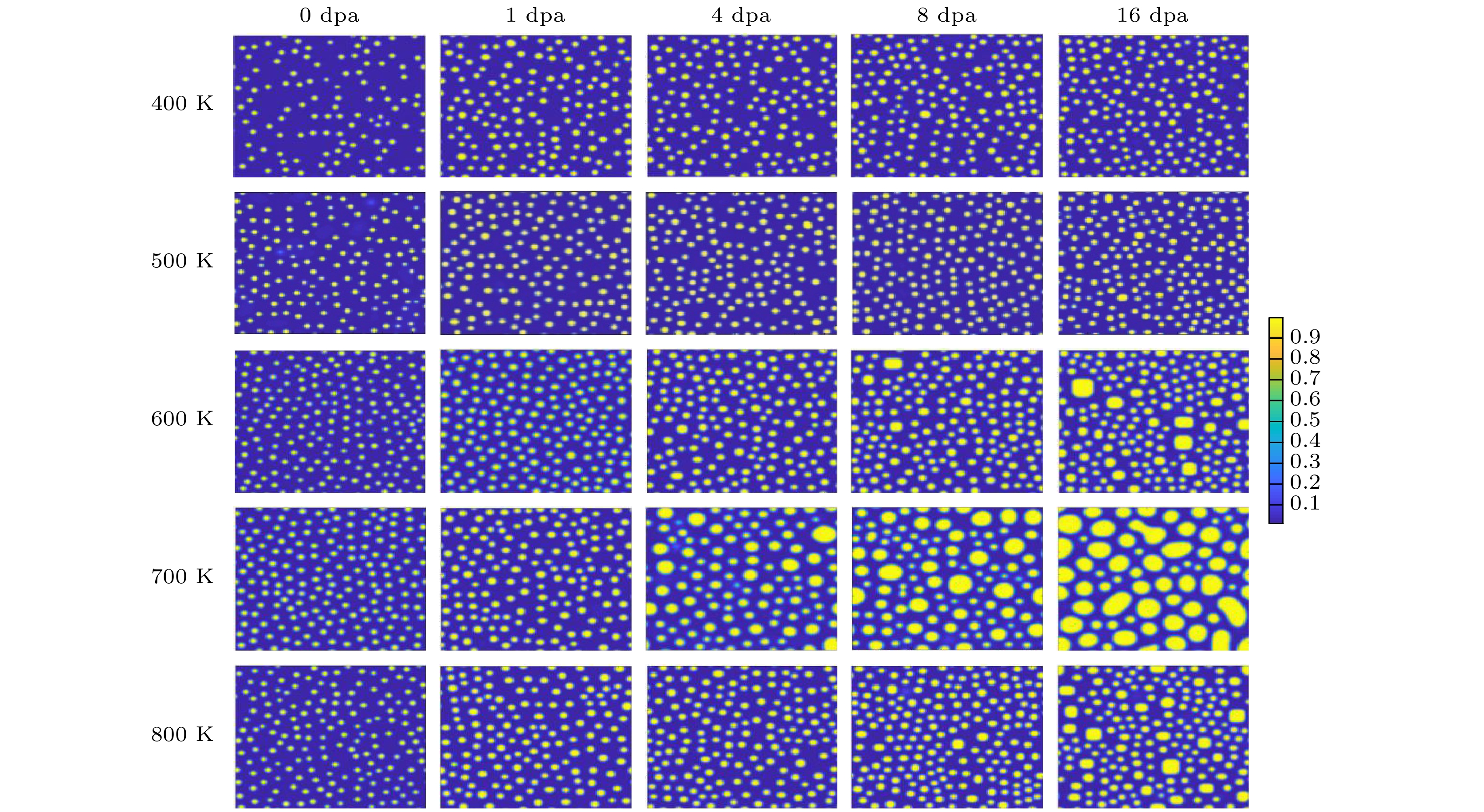
 DownLoad:
DownLoad:


